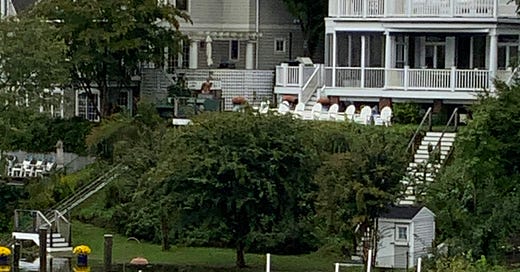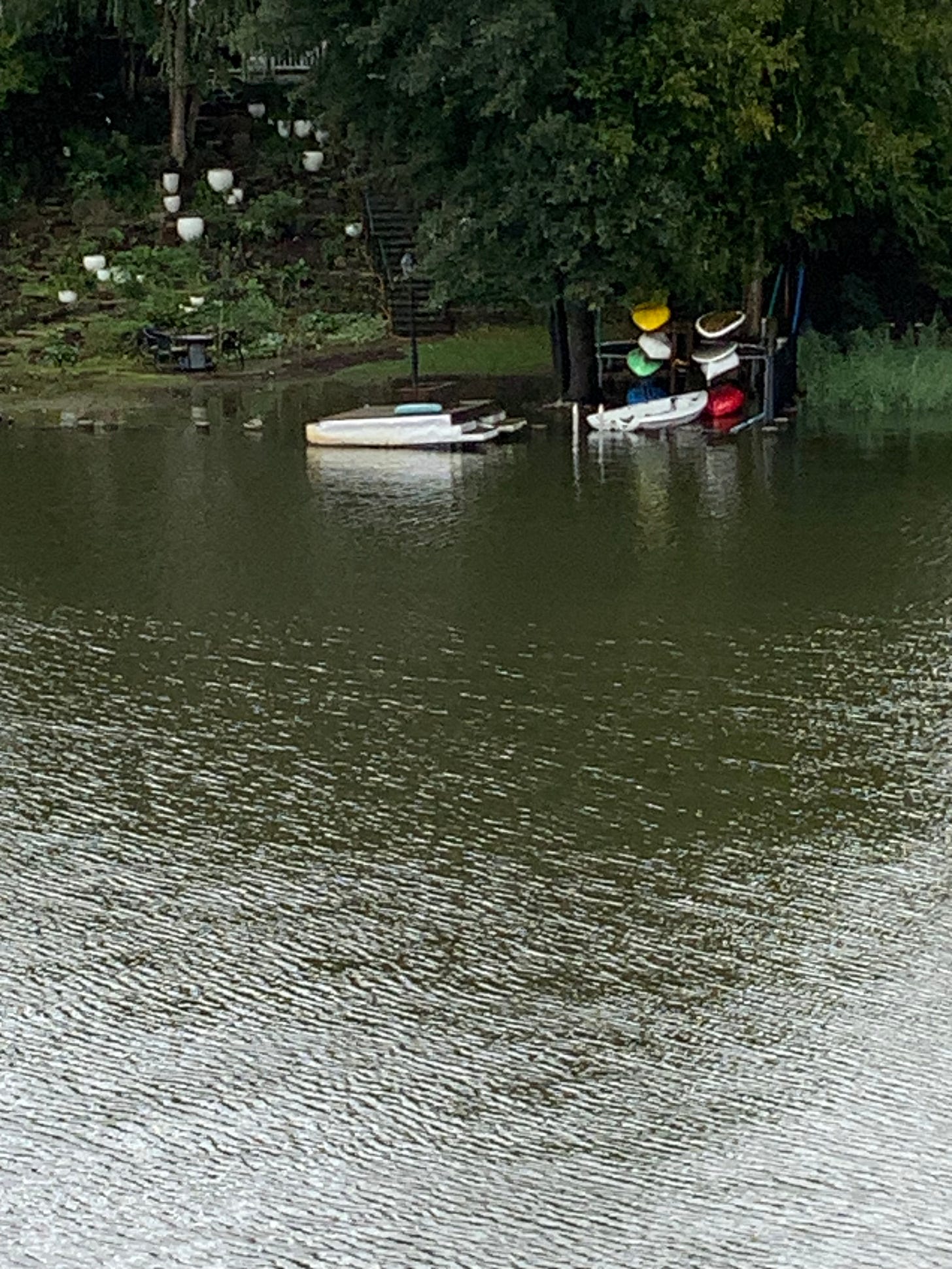We got rain! The 1.21 inches before the record keeping cut off for today’s paper isn’t going to cure our 10+ inch deficit from the average levels but it’s certainly a start. The wind was sustained and strong yesterday to accompany the rain which came in boisterous bands as hurricanes most often do. Thank goodness I have not read of any deaths but plenty of messiness. Considering it’s the end of September, things could have been considerably worse so this presents many things to appreciate relative to ‘Ophelia’ arriving and departing.
Annapolis, Maryland’ capital, is a 1649 town stretching across the confluence of several streams, rivers, and bays. The population is a schmidge over 40,000, expanding on those delightful weekends of beautiful weather or the world famous boat shows occurring next month.
The key in that description, however, is water in this town. I am not a native so I confess I was surprised when I realised the town is really just a series of peninsulas with a sprawling road system to link the various areas. It’s pretty, it’s maritime, and it’s troublesome in its contemporary heart.
While the state capital sits majestically on a hill about half a mile from City Dock, the Naval Academy occupies landfill along the banks of Spa Creek to the south along with the Severn River to the east. Those two bodies are encroaching not only on the sea wall surrounding the Academy grounds but also into the commercial area of Annapolis which serves as the heart of the town. The capital building itself is safe on a small hill but the businesses along City Dock, Compromise Street leading from Annapolis towards the Eastport bridge, and the circle downtown linking everything are all flooding with increased regularity.
After the 1.21 inches (or whatever it was in aggregate after the Capital Gazette went to press), the city is flooded to disturbing levels fairly often. Usually when we see this, authorities deploy warning signs notifying drivers that they can’t get into Annapolis by going over the Compromise Street bridge because of the water spilling well into town.
We happened to drive into town this morning, forgetting about the likely flooding because the storm had not been a direct hit but one that skirted up the shore. We were up to the water before I realised it was there. About 4 inches of water submerged Compromise Street, surprisingly unmarked. Dock Street (where City Dock sits) was also under even more water. I wasn’t worried about the depth of the water because I had just driven it a couple of days back so I felt confident about the structural integrity of the street but isn’t that always how flooding becomes a potential danger?
Annapolis suffered a major hurricane in October 2003, severe enough that some parts of town changed irrevocably. Glorious Stevens Hardware never reopened in its corner location where the sign defiantly reminds passersby of its history prior to the current Mission Barbeque in the location. Several blocks of Main Street, running up towards the Capital circle, were utterly devastated as well. Sure, some of the merchants had sufficient insurance to rebuild but not all. And, as Floridians are learning only too well, insurers will pull out of towns with probabilities too high for repeat flooding as climate change worsens. Government has to fill in the gaps.
These are real people’s lives, investments, and futures. The same is true for the home owners who live adjacent to today’s flooding. Yes, they live there voluntarily but how many of them are in homes owned prior to this shifting context? Increased and encroaching water levels along the eastern seaboard are real as is drought and fire danger in the Sierra footlands most years.
The costs of climate change will affect each and every one of us as things deteriorate. Some expenses will be far higher than others, as the New Yorkers subjected to the 2012 hurricane Sandy found when the city was inundated by unprecedented water from a (hopefully) once in a lifetime event.
But the changes in our physical context and associated threats are now enduring. The longer term issues of climate change are real even in this small town with a famous institution a mile or so from our balcony as the crow flies. The U.S. Naval Academy is where a significant portion of prospective your (unless you are one of the faithful from the U.K. as I am not aware of readers from elsewhere. If you are there, however, please do speak up!!) sea service officers pursue their education. Founded in 1845, this federally-supported educational institution focuses the minds of young women and men as they explore an array of materials preparing them for earning commissions to serve in our Marine Corps and Navy; occasionally someone escapes to another service as well. But this institution prepares those who serve us.
The rising waters threaten the Academy. The Academy, Department of the Navy, and Maryland delegation in Congress are responding with a plan. Eleven months ago, the Academy broke ground on a phased project to address the issue, calling it the ‘Installation Resiliency Plan’. Recognising that storm surge, subsidence, and rising tidewater are only a portion of the panoply of increasing threats, the plan suggests it can protect the Academy and Naval Support Services Annapolis for the next 75 years.
The first portion of the project, with its groundbreaking ceremony last November, for reinforcing the sea wall had a cost of $37.5 million but that is the tip of the iceberg. The entire resiliency effort will require significantly more over its forty year duration. The resiliency plan shows the extensive risk to the Navy facilitites in this town alone.
There are days when climate change seems like someone else’s problem but the costs for federal facilities operating for you and me as citizens and taxpayers are every bit as expensive as the defenses we build against better known threats like adversaries. Yet we are struggling mightily to pay for our priorities—whatever those priorities address— right now.
It’s seductive to associate our internal debates with the personalities governing—or screaming at each other—in Washington as if replacing those individuals would return us to a placid period of responsible behaviour. Instead, looking at the array of challenges we confront for merely the final three quarters of this century is a daunting experience. We need improve our processes as well as our representatives themselves. We also better realise some of these are interrelated problems. Defense spending, for instance, includes installation, personnel costs, and weapons platforms. We live in an expensive society regardless what we are spending on so don’t fall into the trap of thinking only those things you aren’t interested in are the costs; it doesn’t work that way.
Wishing you a quiet Sunday. Thank those of you who pay for subscriptions to this newsletter as I genuinely appreciate your support. Thank each of you for reading it. Please do send comments on this or other topics.
Be well and be safe. FIN
‘Naval Academy Breaks Ground on Sea Wall’ Project’, Navy Ppublic Affairs, 23 November 2022, retrieved at https://www.usna.edu/NewsCenter/2022/11/NAVAL_ACADEMY_BREAKS_GROUND_ON_SEA_WALL_PROJECT.php
‘USNA, NSAA, Release Installation Resiliency Plan’, U.S. Navy Public Affairs, 27 April 2023, retrieved at https://www.usna.edu/NewsCenter/2023/04/USNA,_NSAA_RELEASE_INSTALLATION_RESILIENCY_PLAN.php






There's more than one good reason it's called "The Boat School".